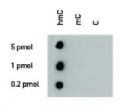1
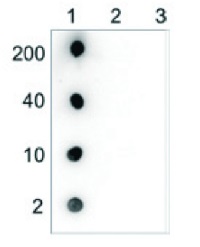
Anti-5-hmC | 5-hydroxymethylcytosine (monoclonal)
- Product Info
-
Sub class: IgG1k Immunogen: BSA-conjugated molecule: 5-hydroxymethylcytosine (5-hmC). Host: Mouse Clonality: Monoclonal Purity: Protein G purified. Format: Liquid Quantity: 100 µg Storage: Store lyophilized/reconstituted at -20°C; for long term storage -80°C is recommened; once reconstituted make aliquots to avoid repeated freeze-thaw cycles. Please remember to spin the tubes briefly prior to opening them to avoid any losses that might occur from material adhering to the cap or sides of the tube. Tested applications: Dot blot (Dot), ELISA (ELISA), hMeDIP (hydroxymethylated DNA Immunoprecipitation (IP) Recommended dilution: 2 µg/ml (Dot), 1 : 500 (ELISA), 2,5 µg/IP (hMeDIP) - Reactivity
-
Confirmed reactivity: Human Predicted reactivity: Mouse, broad species range Not reactive in: No confirmed exceptions from predicted reactivity are currently known - Application Examples
-
application example 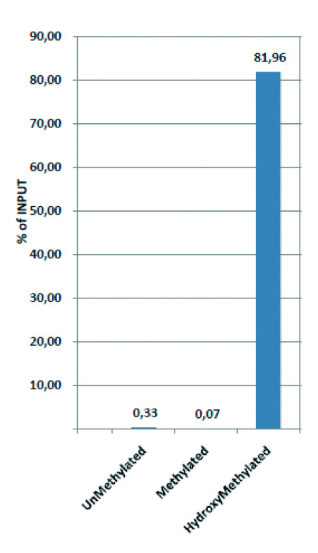
An hydroxymethylated DNA IP (hMeDIP) was performed using the mouse monoclonal antibody directed against 5-hydroxymethylcytosine. The IgG isotype antibodies from mouse was used as negative control. The DNA was prepared with the GenDNA module of the hMeDIP kit and sonicated with our Bioruptor ® (UCD-200/300 series) to have DNA fragments of 300-500 bp. 1 μg of human Hela cells DNA were spiked with non-methylated, methylated, and hydroxymethylated PCR fragments. The IP’d material has been analysed by qPCR using the primer pair specific for the 3 different control sequences. The obtained results show that the mouse monoclonal for 5-hmC is highly specific for this base modification (no IP with non-methylated or methylated C bases containing fragments).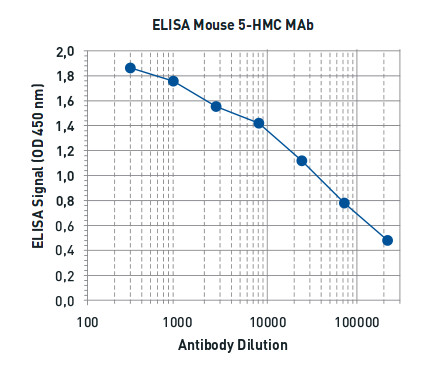
ELISA: To determine the titer, an ELISA was performed using a serial dilution of the mouse monoclonal antibody directed against 5-hmC in antigen coated wells. The antigen used was KHL coupled to 5-hmC base. By plotting the absorbance against the antibody dilution, the titer of the antibody was estimated to be 1:40 000.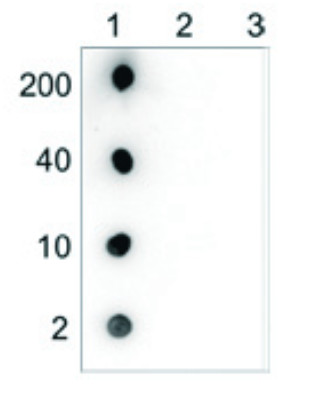
Dot blot: using anty-5-hmC mouse monoclonal antibody with the C, mC and hmC PCR controls 200 to 2 ng (equivalent of 10 to 0.1 pmol of C-bases) of the hmC (1), mC (2) and C (3) PCR controls from the “5-hmC, 5-mC & cytosine DNA were spotted on a membrane (Amersham Hybond-N+). The membrane was incubated with 2 μg/ml of the mouse 5-hydroxymethylcytosine monoclonal antibody (dilution 1:500). The membranes were exposed for 30 seconds. - Additional Information
-
Additional information: Close structural similarity between 5-mC and 5-hmC makes them very difficult to expreimentally distinuish. Therefore affinity-based technology was employed to purify 5-hmC specific antibodies.
This antibody is affinity purified and provided in PBS pH 7.4 with 0.05 % sodium azide. - Background
-
Background: 5-hmC | 5-hydroxymethylcytosine is a recently discovered DNA modification which results from the enzymatic conversion of 5-methylcytosine into 5-hydroxymethylcytosine by the TET family of oxygenases. It may have an important roles distinct from that of 5-methylcytosine (5-mC). 5-hmC bases have been identified in Purkinje neurons, in granule cells and embryonic stem cells where they are present at high levels (up to 0,6% of total nucleotides in Purkinje cells. - Reviews:
-
This product doesn't have any reviews.



